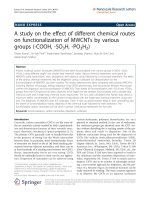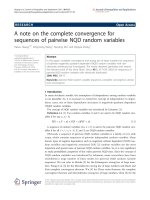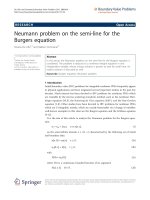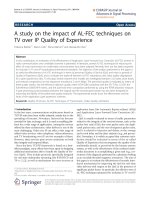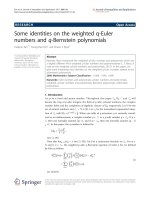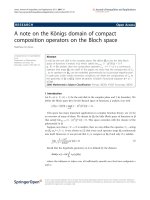Báo cáo hóa học: " Neumann problem on the semi-line for the Burgers equation" pdf
Bạn đang xem bản rút gọn của tài liệu. Xem và tải ngay bản đầy đủ của tài liệu tại đây (260.19 KB, 10 trang )
RESEARC H Open Access
Neumann problem on the semi-line for the
Burgers equation
Silvana De Lillo
1,2
and Matteo Sommacal
3*
* Correspondence: sommacal@ihes.
fr
3
Institut des Hautes Etudes
Scientifiques, 91440 Bures-sur-
Yvette, France
Full list of author information is
available at the end of the article
Abstract
In this article, the Neumann problem on the semi-line for the Burgers equation is
considered. The problem is reduced to a nonlinear integral equation in one
independent variable, whose unique solution is proven to exist for small time. An
explicit solution is discussed as well .
Keywords: Burgers equation, Neumann problem
1 Introduction
Initial/boundary value (IB V) problems for integrable nonlinear PDEs frequently appear
in physical applications and have originated several important studies in the past few
decades. Much interest has been devoted t o IBV problems for nonlinear PDEs which
are treatable by the inverse scattering transform method, such as the nonlinear Shrö-
dinger equatio n (NLS), the Korteweg-de Vries equation (KdV), and the Sine-Gordon
equation [1-8]. Other studies have been devoted to IBV problems for nonlinear PD Es
which are C-integrable, namely, which are exactly linearizable via a change of variables:
well-known examples i n this class are the Burgers equation and the Eckhaus equation
[9-15].
It is the aim of this article to analyze the Neumann problem for the Burgers equa-
tion:
u
t
= u
xx
+2u
x
u, u ≡ u
(
x, t
),
(1)
on the semi-infinite domain x Î [0, ∞ ) characterized by the following set of initial
and boundary data:
u
(
x,0
)
= u
0
(
x
)
, x ≥ 0
,
(2a)
u
x
(
0, t
)
= F
(
t
)
, t ≥ 0
,
(2b)
with
F
(
0
)
= u
0
x
(
0
),
(2c)
where F(t) is a continuous, bounded function of its argument:
F
(
t
)
≤ B, B ∈ R
,
(2d)
De Lillo and Sommacal Boundary Value Problems 2011, 2011:34
/>© 2011 De Lillo and Sommacal; licensee Springer. This i s an Open Access article distributed under the terms of the Creative Commons
Attribution License ( which permits unrestricted use, distribution, and reproduction in
any medium, provid ed the original work is properly cited.
and the initial datum u
0
(x) is assumed to be integrable on the semi-line:
∞
0
|u
0
(x)|dx < ∞
.
(2e)
We point out that such problem was previously considered in [12], where it was
shown to be equivalent to a nonlinear integro-differential equation (in one indepen-
dent variable), which however cannot generally be solved. In this article, our analysis is
based on the method developed i n [10] for the solution of Dirichlet problem and on
the use of the contraction-mapping technique, analogously to what was done fo r the
Eckhaus equation in [15]. In particular, the main result of the present study is to prove
the following.
Theorem 1 There exists a finite constant s Î ℝ,0<s < ∞, such that the solution to
the Neumann problem (2a-2e) for (1) exists and is unique for 0 ≤ t <s.
Unlike the Neumann problem on the finite interval (0,1), for which the existence of a
solution in L
2
(0,1) was proven in [16] by means of the Galerkin method, the
Neumann problem on the semi-line for the Burgers equation has not received much
attention in the literature in the past. To the best of the authors’ knowledge , Theorem
1 (as well as Lemma 1 in Section 3) are new.
InSection2,weputproblem(1,2a-2e)inaone-to-onecorrespondencewitha
Neuma nn problem for the h eat equation, characterized by a boundary datum which is
a nonlinear combination of the boun dary data {u(x,0),u
x
(0,t)} of the Burgers eq uatio n.
We reduce such a problem to a nonlinear integral equation of Volterra type in one
independent variable (t). In Section 3, we prove the existence and uniqueness of
the solution for small time. In Section 4, we discuss a special solution of the problem
(1, 2a-2e).
2 Reduction to a nonlinear integral equation
We begin our analysis by introducing the following ("generalized” Hopf-Cole) linearizing
transformation [11,12]:
υ(x, t)=C(t)u(x, t) exp
x
0
d
˜
xu(
˜
x, t)
,
(3a)
u
(x, t)=
υ(x, t)
C(t )+
x
0
d
˜
x υ(
˜
x, t)
,
(3b)
with
C
(
0
)
=1
.
(3c)
The above transformation maps the Burgers equation (1) into the linear heat equa-
tion
υ
t
(
x, t
)
= υ
xx
(
x, t
)
,
(4)
with the “compatibility” condition for C(t) given by
˙
C(t )=C(t)
u
x
(0, t)+u
2
(0, t)
,
(5)
where (hereafter) the dot indicates differentiation with respect to time. Through
transformation (3a-3c), from the Neumann IBV data for the u(x,t), (2a-2e), we obtain
De Lillo and Sommacal Boundary Value Problems 2011, 2011:34
/>Page 2 of 10
the IBV data for the υ(x,t) that characterize (4):
υ(x,0)=u
0
(x) exp
x
0
d
˜
xu
0
(
˜
x)
,
(6a)
υ
(
0, t
)
= C
(
t
)
u
(
0, t
),
(6b)
υ
x
(0, t)=C(t)
u
x
(0, t)+u
2
(0, t)
=
˙
C(t )
.
(6c)
Comparing (6c) with (5) and making use of (6b) with (2b), we can restate the com-
patibility condition for C(t), (5), in the following shape:
˙
C(t )=C(t) F(t)+
υ
2
(0, t)
C
(
t
)
.
(7)
According to (6c), the boundary datum υ
x
( 0,t ) for the heat equation (4) is a non-
linear combination of known (u
x
(0,t)) and unknown (u(0,t)) boundary data for the Bur-
gers equation (1).
The Neumann problem on the semi-line for υ(x,t) is then in principle solved through
the following prescription:
1. Solve the Neumann problem on the semi-line for υ(x, t), with initial datum (6a)
and (6c);
2. Determine the unknown function C(t)bymeansofthetransformation(3a)and
(3c);
3. Recover u(x,t) via the inverse transformation (3b).
We reduced the problem of solving Burgers equation (1) with the Neumann condi-
tion (2a-2e) to the determination of the couple {υ( x,t),C(t)}, where υ(x,t)solvesthe
heat equation (4) with the Neumann condition (6a-6c) and C(t) simultaneously satisfy-
ing (7).
In order to explicitly evaluate the solution υ(x,t) of (4), as in [12], it is convenie nt to
introduce the cosine-Fourier transform:
υ(x, t)=
2
π
∞
0
dk ˆυ(k, t)cos(k, x)
,
(8a)
ˆυ(k, t)=
∞
0
dx υ(x, t )cos(k, x)
= ˆυ(k,0)e
−k
2
t
−
t
0
d
˜
t υ
x
(0,
˜
t)e
−k
2
(
˜
t−t
)
= ˆυ(k,0)e
−k
2
t
−
t
0
d
˜
t
˙
C(
˜
t)e
−k
2
(
˜
t−t)
,
(8b)
ˆυ(k,0) =
∞
0
dx υ(x,0) cos(kx)
=
∞
0
dxu
0
(x)cos(k, x) e
x
0
d˜
x
u
0
(
˜
x)
.
(8c)
De Lillo and Sommacal Boundary Value Problems 2011, 2011:34
/>Page 3 of 10
Using (8b) and (8c) with (8a), via (7), we equivalently get
υ(x, t)=
2
π
∞
0
dk ˆυ(k,0)cos(kx)e
−k
2
t
−
2
π
∞
0
dk
t
0
d
˜
t
C(
˜
t) F(
˜
t)+
υ
2
(0,
˜
t)
C
(
˜
t
)
cos(kx)e
k
2
(
˜
t−t)
.
(9)
In the right-hand side of (9), υ(0,t)isunknown.Itisthenconvenienttosetz(t) =
υ(0,t) and to calculate left- and right-hand sides of (9) at x =0.Todoso,letusstart
by recalling that
(a) for an arbitrary function of t , g(t), we have
∞
0
dk
t
0
d
˜
tg(
˜
t)e
k
2
(
˜
t−t)
=
√
π
2
t
0
d
˜
t
g(
˜
t)
t −
˜
t
;
b) from the convolution properties of the cosine-Fourier transform (8), we have
2
π
∞
0
dk ˆυ(k,0)e
−k
2
t
=
1
√
πt
∞
0
dx υ(x,0) e
−
x
2
4t
.
From this, at x = 0, we can restate (9) as follows:
z(t)=
1
√
πt
∞
0
dx υ(x,0)e
−
x
2
4t
−
1
√
π
t
0
d
˜
t
˙
C(
˜
t)
t −
˜
t
(10a)
or, via (7),
z(t)=
1
√
πt
∞
0
dx υ(x,0)e
−
x
2
4t
−
1
√
π
t
0
d
˜
t
1
t −
˜
t
C(
˜
t)F(
˜
t)+
z
2
(
˜
t)
C(
˜
t)
.
(10b)
˙
C(t )=C(t) F(t)+
z
2
(t )
C
(
t
)
, C(0) = 1
.
(10c)
Making use of (10a), we can put in a more explicit form the previously given pre-
scription to solve the Neumann problem on the semi-line, (1) and (2a-2e), for u(x, t):
1. Given the Neumann data on the semi-line, (2a-2e), compute C(t) by substituting
(10b) into (10c), namely, from the following nonlinear integro-differential equation:
C(t )
˙
C(t)=F(t) C
2
(t )
+
1
√
πt
∞
0
dxu
0
(x)e
−
x
2
4t
+
x
0
d
˜
xu
0
(
˜
x)
−
1
√
π
t
0
d
˜
t
˙
C(
˜
t)
t −
˜
t
2
(11)
with C(0) = 1 as in (3c);
2. Evaluate the solution to the heat equation (4) w ith IBV data (6a-6c), υ(x,t), by
means of (8a) making use of (8b) and (8c);
3. Recover u(x,t) from υ(x,t) via (3b).
For arbitrary u
0
(x)andF(t), there is no general technique for solving a nonlinear
integro-differential equation like (11). On the other hand, the determination of the
solution u(x,t) has been reduced to the solution of the nonlinear integral equation
(10b)–with C(t) satisf ying (10c)–for only one independent variable (t). In the next sec-
tion, we prove the existence and uniqueness of the function z(t)for0≤ t <s,with0
De Lillo and Sommacal Boundary Value Problems 2011, 2011:34
/>Page 4 of 10
<s < ∞ (Lemma 1). Once the existence and uniqueness of z(t) are established, the exis-
tence and uniqueness of υ(x,t)for0≤ t <s then follow, via (9), with C(t )being
obtained via ( 10c). Then, via the inverse transformation (3b), Theore m 1 immediatel y
follows, namely the solution of the original Neumann problem (2a-2e) for the Burgers
equation (1) exists and is unique (for 0 ≤ t <s).
3 Contraction mapping
In order to analyze the existence properties of z(t)for0≤ t <s < ∞, we denote by S
M
(s) the closed sphere ||z|| ≤ M in the Banach space of continuous functions z(t)fort
Î [0,s), with the uniform norm ||z|| = l.u.b.|z(t)|.OnthesphereS
M
(s ), we introduce
the transformation:
w
(
t
)
=
T
z
(
t
),
(12)
where
T z
(
t
)
coinc ides with the right-hand side of (10b). To prove the existence and
the uniqueness of the solution of the integral equation (10b) for a finite interval of
time, we will prove the following:
Lemma 1 The mapping operator
T
is a contraction mapping in S
M
(s) for t Î [0,s).
In order to prove this Lemma, we need to prove that, for t Î [0, s),
T
is closed and
contractive in S
M
(s).
3.1 Closure of
T
in S
M
(s) for t Î [0,s)
We need to prove that if z(t) Î S
M
(s)thenw(t) Î S
M
(s) as well, namely that ||z(t)|| ≤
M for t Î [0,s) entails
w(t )
=
T z(t)
≤
M
for t Î [0,s).
The first step is to obtain an upper and lower bounds for |C(t)|. Integrating (10c), we
obtain
C
2
(t )=e
2
t
0
dt
F(t
)
1+2
t
0
dt
z
2
(t )e
−2
t
0
dt
F(t
)
.
(13)
From the fact that |e
x
|=e
x
≤ e
|x|
for any x Î ℝ, applying the triangular inequal ity (|
x| - |y| ≤ |x + y| <|x| + |y|) on (13) we get
|
C(t ) |≤
e
t
0
dt
F(t
)
1+2
t
0
dt
z
2
(t )e
−2
t
0
dt
F(t
)
1
/2
≤ e
σ B
1+2M
2
σ e
2σ B
1/2
,
(14a)
|
C(t ) |≥
e
t
0
dt
F(t
)
1+2
t
0
dt
z
2
(t )e
−2
t
0
dt
F(t
)
1
/2
≤ e
σ B
1+2M
2
σ e
2σ B
1/2
;
(14b)
imposing the last right-hand side o f (14b) to be strictly greater than zero, we have
the following condition on s:
0 ≤ σ<
W(
B
M
2
)
2 B
,
(14c)
where W is the Lambert-W function, implicitly defined as the inverse function of f
(W)=W e
w
De Lillo and Sommacal Boundary Value Problems 2011, 2011:34
/>Page 5 of 10
The second s tep, is to obtain an upper bound for
T z
(
t
)
. Applying the triangular
inequality on (10b), via (16), we get
T z(t)
≤
1
√
πt
∞
0
dx υ(x,0)e
−
x
2
4t
+
1
√
π
t
0
d
˜
t
C(
˜
t) F(
˜
t)
t −
˜
t
+
1
√
π
t
0
d
˜
t
z
2
(
˜
t)
C(
˜
t)
t −
˜
t
(15)
From (6a) and (2e) we can write
υ(0, x) ≤
u
0
(x)
exp
u
0
(x)
≡ A
;
(16)
then, for the first term on the right-hand side of (15), we get
1
√
πt
∞
0
dx υ(x,0)e
−
x
2
4t
≤ A
1
√
πt
∞
0
dx e
−
x
2
4t
= A
.
(17a)
For the second and the third terms in the right-hand side of (15), inequalities (14a-
14c) and (2d) entail
1
√
π
t
0
d
˜
t
C(
˜
t) F(
˜
t)
t −
˜
t
≤
2B
√
σ e
σ B
√
π
√
1+2M
2
σ e
2σ B
,
(17b)
1
√
π
t
0
d
˜
t
z
2
(
˜
t)
C(
˜
t)
t −
˜
t
≤
2M
2
√
σ
√
π e
σ B
√
1+2M
2
σ e
2σ B
.
(17c)
Defining M = aA, with a > 1, and combining (15) with (17a-17c), we get
w(t )
≤ M
1
α
+ β(σ )
,
(18a)
where
β(σ )=
2
√
σ
√
π
⎛
⎜
⎜
⎝
B e
σ B
1
M
2
+2σ e
2σ B
+
1
e
σ B
1
M
2
− 2σ e
2σ B
⎞
⎟
⎟
⎠
,
(18b)
with s satisfying condition (14c). On the other hand, in the interval
σ ∈
0,
w(B/M
2
)
2B
,forB > 0 and M >0,b(s) is a monotonic, increasing bijective func-
tion on the positive Reals, and so there exists a value
σ ∗ <
w(B/M
2
)
2B
such that
1
α
+ β(σ ) ≤ 1 ∀ σ ∈ [0, σ ∗]
.
(18c)
Taking s ≤ s*, from (18a), we have ||w(t)|| ≤ M. Thus the mapping
T
is closed. □
De Lillo and Sommacal Boundary Value Problems 2011, 2011:34
/>Page 6 of 10
3.2 Contractivity of
T
in S
M
(s) for t Î [0,s)
We need to prove that, given two solutions of (12), z(t) and ẑ(t), with ||z(t)-ẑ(t)|| = δ <
2M; it then follows that
T z(t) −T ˆz(t)
≤ θ
δ
with 0 <θ <1.
We now write
w −
ˆ
w
=
1
√
π
t
0
d
˜
t
F(
˜
t)
C(
˜
t) −
ˆ
C(
˜
t)
t −
˜
t
+
t
0
d
˜
t
1
t −
˜
t
z
2
(
˜
t)
C(
˜
t)
−
ˆz
2
(
˜
t)
ˆ
C(
˜
t)
=
1
√
π
t
0
d
˜
t
˙
C(
˜
t) −
˙
ˆ
C(
˜
t)
t −
˜
t
.
(19)
Let us recall
X(t)=
z(t)
C(t )
and
ˆ
X(t)=
ˆz(t)
ˆ
C(t )
.
(20)
Notice that, if
σ ≤ σ ∗ <
0,
w(B/M
2
)
2B
,then,for0≤ t ≤ s, v ia (14a) and (14b), we
have that C(t) is a nonzero bounded function of t:
e
σ B
1 −2M
2
σ e
2σ B
1/2
≤|C(t ) |≤e
σ B
1+2M
2
σ e
2σ B
1/
2
thus X(t) and
ˆ
X
(
t
)
are bounded functions of t as well.
The identity
z
2
(t )
C(t )
−
ˆz
2
(t )
ˆ
C(t )
=[z(t) −ˆz(t)]
z(t)
C(t )
−
ˆz(t)
ˆ
C(t )
−
z(t)
C(t )
−
ˆz(t)
ˆ
C(t )
C(t ) −
ˆ
C(t )
,
(21)
entails
˙
C(t ) −
˙
ˆ
C(t )
≤
B + X(t)
ˆ
X(t)
C(t ) −
ˆ
C(t )
+ |z(t) −ˆz(t)|
X(t)+
ˆ
X(t)
=[B +
˜
R
1
(t )]
C(t ) −
ˆ
C(t)
+
˜
R
2
(t ) |z(t) −ˆz(t) |,
(22)
where
˜
R
1
(
t
)
= X
(
t
)
ˆ
X
(
t
)
and
˜
R
2
(
t
)
= X
(
t
)
ˆ
X
(
t
).
(23a)
Let us recall
R
1
=max
˜
R
1
(t )
and R
2
=max
˜
R
2
(t )
,
0
≤
t
≤
σ ∗ 0
≤
t
≤
σ ∗
(23b)
existence and well-definedness of which are implied by our previous considerations
about the boundedness of C(t).
Since, for an arbitrary function of t, g(t), we have that
dg(t)
dt
≥
d
g(t)
dt
, from (22),
we can write
d
C(t ) −
ˆ
C(t )
dt
≤ ( B + R
1
)
C(t ) −
ˆ
C(t )
+ δR
2
,
(24)
De Lillo and Sommacal Boundary Value Problems 2011, 2011:34
/>Page 7 of 10
or, integrating once with initial condition |C(0)-Ĉ(0)| = 0,
C(t ) −
ˆ
C(t)
≤
e
(B+R
1
)
σ
− 1
δ
R
2
B + R
1
,
(25a)
d
C(t ) −
ˆ
C(t )
dt
≤ δR
2
e
(B+R
1
)σ
.
(25b)
Formula (25b), via (19), implies
w(t ) −
ˆ
w(t )
≤ θδ with θ =
2
√
σ R
2
√
π
e
(B+R
1
)σ
.
(26)
Choosing
σ<min
⎧
⎨
⎩
σ ∗,
W
π(2+R
1
)
2 R
2
2
2(2 + R
1
)
⎫
⎬
⎭
,
(27)
we get θ < 1 and, for what we saw in the previous Subsection 3.1, the mapping
T
remains closed. Thus, Lemma 1 is proved, namely,
T
is a contraction operator on S
M
(s). □
Lemma 1 means that there exists a unique fixed point
z(
t
)
= T z
(
t
)
of
T
in S
M
(s),
for 0 ≤ t ≤ s. We have thereby proven the existence and uniqueness of the solution of
the integral equation (10b) for 0 ≤ t <s.Then,asexplainedattheendofSection2,
from the existence and uniquenes s of z(t)intheinterval0≤ t <s,weget,via(9)and
(10c), the existence and uniqueness of υ(x,t) in the same interval, and via the inver se
transformation (3b), we immediately get Theorem 1.
4 A special solution
In this section, we consider a particular solution of the Neumann problem (2a-2e) for
the Burgers equation (1), and derive the corresponding expression for z(t).
A solution to the Burgers equation is given by
u
(x, t)=
(1 −e
A
)e
−
x
2
4(t+t
0
)
π(t + t
0
)
2 −(1 −e
A
)
1 −erf
x
2
(
t + t
0
)
,
(28)
where A and t
0
> 0 are two real constants and
e
rf(x)=
2
√
π
x
0
dξ e
−ξ
2
.
From (28), we obtain for the squared modulus
u(x, t)
2
=
H
2
[y(x, t)]
t + t
0
,
(29a)
Where
H(y)=
√
π e
y
2
coth
A
2
− erf(y)
−1
,
(29b)
De Lillo and Sommacal Boundary Value Problems 2011, 2011:34
/>Page 8 of 10
and
y(x, t)=
x
2
√
t + t
0
.
(29c)
Thus the solution (28) on the whole line is a single hump with (negative) peak value
given by
u
(x
p
, t)=
y
p
√
t + t
0
,
(30a)
where y
p
is the solution of the equation
y
p
= H ( y
p
)
;
(30b)
the peak value is attained at
x
p
=2y
p
√
t + t
0
(30c)
and moves to the left with velocity
dx
p
dt
=
y
p
√
t
.
(30d)
The corresponding initial datum and boundary condition, which associate the given
solution (28) to the Burgers equation (1) are
u
(x,0) =u
0
(x)=
(1 −e
A
)e
−
x2
4t
0
√
πt
0
2 −(1 −e
A
)
1 −erf
x
2 t
0
,
(31a)
u
x
(0, t)=F(t)=−
tanh
2
(
A
2
)
π
(
t + t
0
)
.
(31b)
Notice that, if t
0
= 0, then, from (31a), it turns out t hat u
0
(x) = Aδ(x), where δ(x)is
the Dirac delta function; in this case, all the following calculations can still be
performed.
Next, we prove that (28) considered on the semi-line x Î [0, +∞) is a particular solu-
tion of the Neumann problem (2a-2e) for the Burgers equation (1). To this end, we
start noting that from the solution (28), we get
u
(0, t)=−
tanh(
A
2
)
π(t + t
0
)
,
(32)
so that
u
x
(
0, t
)
+ u
2
(
0, t
)
=0
;
(33)
this last relation, via (5) and (3c), implies
C
(
t
)
=1
,
(34)
which in turn, from (6b) and (32), implies
z(t)=υ(0, t)=u(0, t)=−
tanh(
A
2
)
π(t + t
0
)
.
(35)
De Lillo and Sommacal Boundary Value Problems 2011, 2011:34
/>Page 9 of 10
On the other hand, it is now immediate to see that the integral equation (10b), when
(34) and (35) are used, reduces to
z(t)=
1
√
πt
∞
0
dx υ(x,0)e
−
x
2
4t
,
(36a)
υ(x,0)=−
tanh(
A
2
)
√
πt
0
e
−
x
2
4t
0
.
(36b)
An expl icit computation of th e integral (3 6a) with (36b) yields immediately the same
expression (35) for z(t).
Acknowledgements
The authors wish to thank M. J. Ablowitz for enlightening discussions on this topic. MS wishes to thank T. Horikis and
M. Hoefer, particularly the latter for bringing to his attention a different way to linearize (1).
Author details
1
Dipartimento di Matematica ed Informatica, Universi tà degli Studi di Perugia, 06123 Perugia, Italy
2
INFN, Istituto
Nazionale di Fisica Nucleare, Sezione di Perugia, Italy
3
Institut des Hautes Etudes Scientifiques, 91440 Bures-sur-Yvette,
France
Authors’ contributions
The authors declare that the work was realized in collaboration with the same responsibility. All authors read and
approved the final manuscript.
Competing interests
The authors declare that they have no competing interests.
Received: 28 April 2011 Accepted: 14 October 2011 Published: 14 October 2011
References
1. Fokas, AS, Its, AR: Soliton generation for initial-boundary value problems. Phys Rev Lett. 68, 3117–3120 (1992)
2. Fokas, AS: A unified transform method for solving linear and certain nonlinear PDEs. Proc R Soc Lond A. 53, 1411–1443
(1997)
3. Degasperis, A, Manakov, SV, Santini, PM: On the initial-boundary value problem for soliton equations. JEPT Lett. 74,
481–485 (2001)
4. Degasperis, A, Manakov, SV, Santini, PM: Initial-boundary value problems for linear and soliton PDEs. Theor Math Phys.
133, 1475–1489 (2002)
5. Fokas, AS: On the integrability of linear and nonlinear partial differential equations. J Math Phys. 41, 4188–4237 (2000)
6. Fokas, AS, Pelloni, P: Two-point boundary value problems for linear evolution equations. Math Proc Camb Phil Soc. 131,
521–543 (2001)
7. Grinevich, P, Santini, PM: The initial-boundary value problem on the interval for the nonlinear Schrdinger equation. The
algebro-geometric approach. I Am Math Soc Transl 212, 157–178 (2004). Adv. Math. Sci. Appl. 55
8. Fokas, AS, Stuart, JT: The time periodic solution of the Burgers equation on the half-line and an application to steady
streaming. J Nonlinear Math Phys. 12, 302–314 (2005)
9. Calogero, F, De Lillo, S: The Eckhaus PDE iψ
t
+ ψ
xx
+ 2(|ψ|
2
)
x
ψ +|ψ|
4
ψ = 0. Inverse Problems. 3, 633–681 (1987)
10. Calogero, F, De Lillo, S: Cauchy problems on the semiline and on a finite interval for the Eckhaus equation. Inverse
Problems. 4, L33–L37 (1988)
11. Calogero, F, De Lillo, S: The Burgers equation on the semi-infinite and finite intervals. Nonlinearity. 2,27–43 (1989)
12. Calogero, F, De Lillo, S: Burgers equation on the semiline. Inverse Problems. 5, L37–L40 (1989)
13. Calogero, F, De Lillo, S: The Burgers equation on the semiline with general boundary conditions at the origin. J Math
Phys. 32,99–105 (1991)
14. Ablowitz, MJ, De Lillo, S: Forced and semiline solutions of the Burgers equation. Phys Lett A. 156, 483–487 (1991)
15. De Lillo, S: Neumann problem on the semi-line for the Eckhaus equation. Nonlinearity. 18, 2365–2372 (2005)
16. Zhu, M, Zhao, Z: Optimal Control of Nonlinear Strength Burgers Equation under the Neumann Boundary Condition. Int
J Nonlinear Sci. 2(1), 111–118 (2006)
doi:10.1186/1687-2770-2011-34
Cite this article as: De Lillo and Sommacal: Neumann problem on the semi-line for the Burgers equation.
Boundary Value Problems 2011 2011:34.
De Lillo and Sommacal Boundary Value Problems 2011, 2011:34
/>Page 10 of 10


